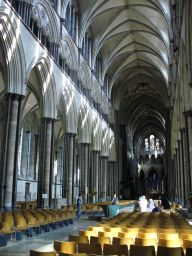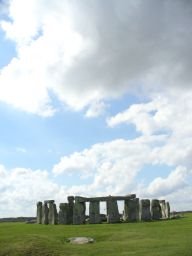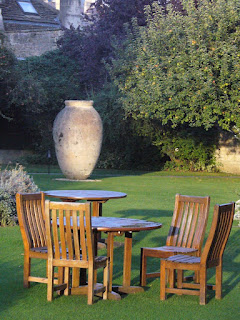Brighton was everything I expected it to be. The Brighton of my imagination was a little jaded, slowly decaying, and filled with cliche English seaside kitsch. This was exactly the landscape that greeted Garry and me on our first visit this weekend. It really is a time capsule. The striped deckchairs, Victorian hotel facades and colourful merry-go-round remind you of an era when any beach, even one covered in pebbles, was a rare and unique luxury for most people.
Our first moment in Brighton was magic. Moments after wandering out of our seafront hotel, the sunset was a giant orange ball over the English Channel. It seemed a fitting end to the autumn solstice we'd celebrated early that day in Stonehenge.
We made our way along the promenade to
Brighton Pier. This 525-metre structure celebrated its first century in May 1999 and is the last of three that still survives. You can still see the remains of a second, older pier, the West Pier, which sits rusting 600 metres along the shore. This pier, built in 1866, caught fire in 2003 and has yet to be rebuilt.
Brighton Pier itself consists of an endless array of sideshows, arcades and restaurants. A sort of mini Sydney Easter Show permanently playing on the English coast. I stopped to revive a childhood memory and bought a toffee apple from one of the many candy stands. While we wandered a constant crunching noise hovered in the background. It wasn't long before we realised that this was the sound of people on the beach.
Brighton's beach consists of pebbles - small, smooth brown pebbles. There is no sand. As you walk across its surface the sound is that of crossing gravel. Only the Victorians could have considered this an ideal holiday location. The stony beach also goes some way to explaining the love of deck chairs and seaside amusements. You'll never catch me spreading a towel and bedding down for a quiet sun-bake.
We eventually found ourselves in Duke Street, a few blocks back from the shore. It was here we discovered Havana. This was a delightful, chic restaurant set in a neo-classical building. The decor was stunning, transporting you back in time to colonial Cuba. As we entered a live jazz band was settling in for the evening.
We ate dinner upstairs in the narrow galleries. Our table overlooked the
main atrium where fans revolved lazily on the white-painted ceiling, above palms and comfortable lounges. I called Mum to wish her birthday before tucking into a perfect tuna steak.
Sunday morning was spent wandering The Lanes, the city's oldest neighbourhood. This is an area of narrow alleyways covering several city blocks. It consists of jewellers, antique shops, restaurants and pubs. We also made a quick diversion to see the Royal Pavillion, a former palace built for the Prince Regent in the early 1800s. It is a most remarkable building. The architecture is predominately Indian and Oriental, quite at odds with the surrounding streetscape.
Early afternoon, we checked out, loaded our bags into the car and headed for Arundel Castle, about 20 miles away. We'd seen this spectacular Norman Castle from the roadside the previous day and were dying to explore it. I'll share more in my next post.
Note the midday shadows!




















































